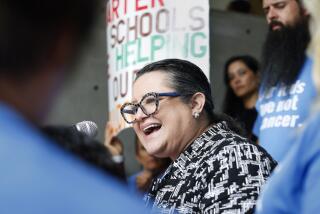The Next L.A. / Reinventing Our Future : Education : IDEA FILE: Alternative School Sites
- Share via
How It Works: Private schools with empty seats would accept students from Los Angeles Unified and other districts who lost classroom space in the quake. The school district could keep any difference between the tuition and the $4,200 it receives from the state for each child. In addition, private firms would make classroom space available at their offices or production facilities, contracting with the district to provide teachers and run the education program. Surplus office, industrial or retail space also could be used.
Benefits: Based on the high volume of empty office space in Downtown L.A., near crowded schools, and the numbers of seats available on some private campuses (mostly Catholic or other religiously affiliated schools), it could quickly provide space for the hundreds of quake-displaced students. Because tuitions at most private schools with empty seats are lower than what the state provides for each child in public school, the plan could be a source of cash for the financially strapped district.
Short-term or long-term impact? Both.
Supporters: Work site schools, sometimes called satellite schools, are quite feasible and already are in operation on a limited, experimental basis in California and other parts of the nation. Advocates say it would give parents a wider choice of schools. If schools were to be set up at parents’ work sites, it also would enable parents to be closer to their children during the day and might cut down on commuting time by eliminating the need for a separate trip to school. Using empty office space would reduce the need for busing thousands of students from crowded neighborhoods.
Opponents: The taxpayers, through the district, would no longer have oversight of the students they would be paying to educate in private institutions, which are much less regulated than public ones. Work sites may not meet the same safety standards as traditional school buildings, and they would almost certainly lack gyms, athletic fields, science labs or other special facilities. The students with special needs probably could not be accommodated at either private schools or work-site schools. Ensuring quality control would be a problem.
The Costs: They would vary, depending on the arrangements, but using private facilities could save money for the school district, especially if employers picked up the tab for readying and maintaining the buildings.
REALITY CHECK: Work sites and office-space proposals: Highly likely.
Private schools: Unlikely.
More to Read
Sign up for Essential California
The most important California stories and recommendations in your inbox every morning.
You may occasionally receive promotional content from the Los Angeles Times.









